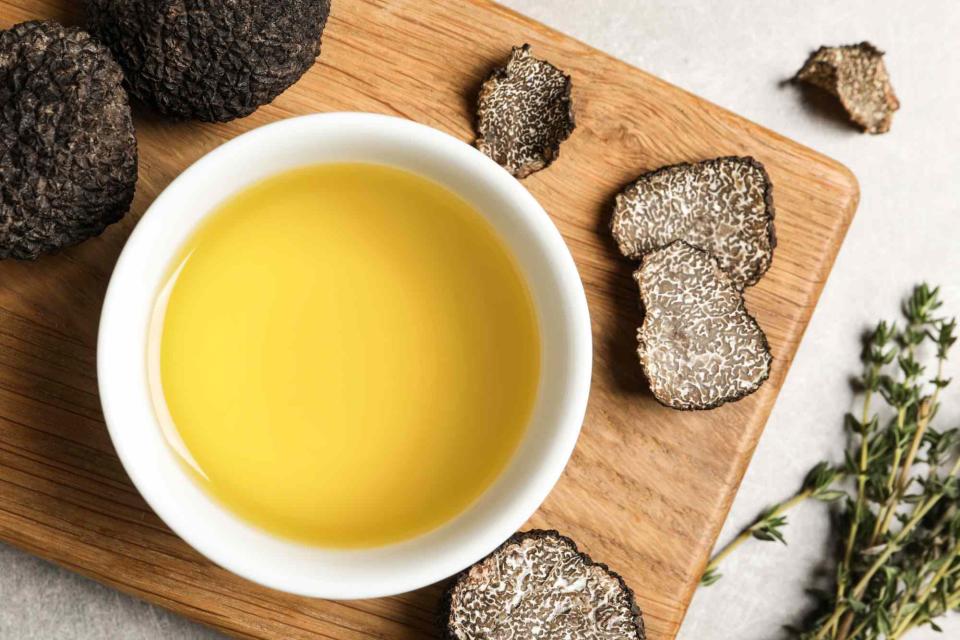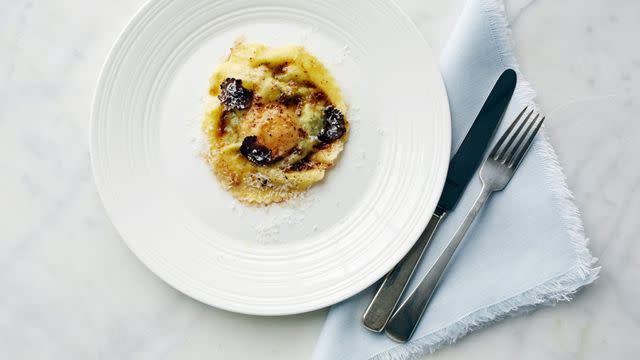What Are Truffles—and Why Are They So Expensive?
Experts share why fresh black and white truffles have a hefty price tag. Plus, the best ways to enjoy this luxury food at home.

Some of the most prized and priciest dishes on restaurant menus feature truffles. A few shavings over a plate of pasta, for example, can wow your tastebuds—and cost you a pretty penny. Lumpy and strange-looking, truffles have always been highly sought-after. Once treasured by emperors and kings, they've attained near-mythical status thanks to their limited supply and fantastic flavors. Learn what makes truffles so precious and elusive, plus some of the best ways to enjoy this delicacy at home, according to experts.
Meet Our Expert
Robert Chang, managing director and chief truffle officer, American Truffle Company
Jason McKinney, CEO and co-founder of Truffle Shuffle
Related: Does Affordable Caviar Exist?
What Are Truffles?
One of the most unique foods on the planet, truffles are difficult to categorize and often confused with mushrooms. Mushrooms grow above ground; truffles are subterranean, growing in and amongst the roots of certain kinds of trees, particularly oaks. Technically, they are the edible spore-producing part of the fungi family Tuberaceae. Tuberaceae are not tubers but are shaped like tubers and can be as small as an acorn or as large as an orange.
Why Are Truffles so Expensive?
Rarity and availability impact truffle price. Truffles grow in wild forests—you can't plant them in your garden—and only during a few months of the year. The most well-known truffle hotspots are in France, Italy, and Spain, although the Pacific Northwest and Australia are also on the truffle map.
Cultivated Truffles
Cultivating truffles is relatively new and extremely complicated. Truffles are now cultivated on plantations called truffières, but they are very high-maintenance and require a complex combination of conditions to grow. First, they have symbiotic relationships with particular types of trees and grow near their roots. This is known as mycorrhizae. Truffles also need cool winters and damp springs followed by hot summers with moderate rain. They grow slowly (it can take six to seven years to get a harvest) and have a short season.
Wild Truffles
Because truffles live underground, they have a strong aroma that attracts animals who dig them up and disperse them, allowing them to proliferate. Humans can't smell them when they are below the soil, so truffle hunters train dogs to hunt for them in forests, often at night. (Pigs are traditional but have fallen out of favor among hunters.) It's a labor-intensive process with a price tag that reflects the work.
Types of Truffles
You may have heard of black and white truffles, the two best-known and most sought-after varieties, but there are many, many other kinds of truffles. Just as there are thousands of different mushrooms, there are thousands of different truffles, says Robert Chang, managing director and chief truffle officer of the American Truffle Company, which helps to cultivate truffles, sells them, and also leads the Napa Truffle Festival. Not all truffles are edible, however, and not all as attractive to humans.

Black Truffles
Black truffles have notes of chocolate, and deep musk, earthy, oaky, nutty aromas. Chang notes that there are over 300 flavor compounds in real truffles, which makes the complexity of their flavor impossible to truly reproduce artificially.
There are several kinds of edible black truffles, and because they are very expensive (over $100 an ounce), it's important to know which type you are getting when buying them.
Winter truffle: The most prized is the Tuber melanosporum, also known as the Périgord truffle or winter truffle. Found in Italy and France, it's now cultivated worldwide.
Summer truffle: The Tuber aestivum, or summer truffle, is generally less expensive and less potent, and is also cultivated around the globe. According to Chang, about 95 percent of the black truffles in France are now cultivated.
Burgundy truffle: Once considered a different black truffle, the Burgundy truffle, or Tuber uncinatum, is the same species as the Tuber aestivum. The two truffles grow in slightly different climates.
Related: Why You Shouldn't Buy Truffle Oil
White Truffles
While black truffles can be cultivated, white truffles cannot, making them the most precious—and pricey—of all.
These white truffles command high prices:
White Alba: Tuber magnatum pico, also known as the tartufo d'Alba, Piedmont, or white truffle, is found primarily in Italy. It has a scent reminiscent of oak, nuts, and sweet soil, and because it is so elusive and delicate, is up to five times as expensive as black truffles, selling for as much as $4,000 a pound. Its season is September to December.
White Bianchetti truffle: Similar in taste to the tartufo d'Alba, but lesser known, this small, pale yellow truffle, also called tartufo bianchetto, Tuber borchii, or marzuolo, has an earthy, garlicky flavor. It's harvested in Tuscany and Emilia-Romagna in March and April.
Oregon white truffle: Tuber oregonese., a white truffle found in Oregon, has a different aroma than European truffles, often described as more herbal and floral.
The Best Way to Enjoy Fresh Truffles
If you're lucky enough to get your hands on fresh truffles, use them right away, advises Chang, because their aroma disappears so quickly. "You can take advantage of the aroma by putting them in a sealed box with some fresh eggs," he says. "The aroma will penetrate and infuse the yolks in 48 hours. Then you can make omelets or scrambled eggs from the truffle-infused eggs."
Crowning Glory
Black truffles are generally used to finish a dish. If used in cooking, they might be placed on top of fish or under the skin of chicken, says Jason McKinney, a chef who worked at The French Laundry and is the CEO and co-founder of Truffle Shuffle, a company that teaches cooking classes and sells both truffles and truffle products.
Because they are so rare, white truffles are generally used fresh as a finishing touch, not in cooking. "We make a white truffle butter once a year in small batches, just to preserve them," says McKinney.
Perfect Pairings
McKinney and Chang both recommend using a microplane or truffle shaver to release the flavor of raw truffles over warm dishes. Oddly, truffles have very little flavor if eaten raw and cold. Since their aroma compounds are oil-soluble, it's best to shave them over dishes that contain eggs, butter, cream, or cheese, including pasta, risotto, pizza, mashed potatoes, cauliflower purée, or omelets.
Read the original article on Martha Stewart.

